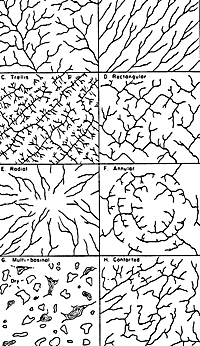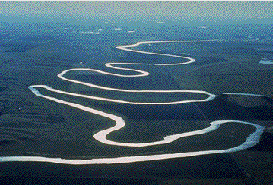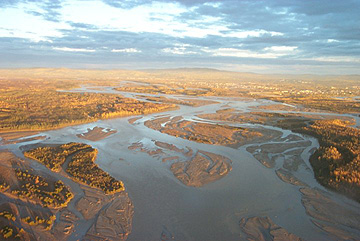
...to Geog 111 Main Page and Course Description
...to Geog 111 Syllabus
...to Geog 111 Course Schedule and Lecture Outlines
...to Geog 111 Course Project
Where we are...
The Process of Studying Landforms
Internal Processes: building up landforms
External Processes: breaking down landforms: forces in atmosphere + hydrosphere
Denudation: disintegration, wearing away, and removal of rock material; implies a lowering of earth's surface (via wearing away, not internal processes)
McKnight 9.5: The Hydro Cycle
Weathering and mass wasting enhanced by presence of water: hydro cycle
But erosion is fundamentally the result of the presence of water
Fluvial Processes: any environmental processes involving the flow of water
1. Impact of Fluvial Processes on the Landscape
McKnight 16.1: Fluvial Process Photo
1a. Traditional Theory of Landform Development: The Geomorphic Cycle
McKnight 16.35a, b, c, d: Davisian Geomorphic Cycle
1b. Critique of Davisian Cycle Theory: Crustal Change and Slope Development
McKnight 16.36: Slope Retreat: Penck
Further problem: both Davis and Penck assumed uniformity of bedrock and tectonics
Much variation in bedrock, regolith, soil around the earth: some soft, some hard
Crustal movement (vertical, horizontal) also varies: excessive uplift, minimal uplift
McKnight 16.37: Dynamic Equilibrium
Simultaneous uplift (internal forces) and denudation (external forces, primarily water)
Dynamic equilibrium rather than evolution
Both Davisian evolution and Dynamic Equilibrium theories explain some landforms
Key: geographic variations (where) in bedrock and tectonic activity vital to understand
2. Fundamental Definitions and Concepts of Fluvial Processes
McKnight 16.2: Valleys and Interfluves
2a. Valleys and Interfluves
2b. Drainage Basins - Watersheds
2c. Erosion
Weathering >> Mass wasting >>
Two basic types of erosion: by overland flow and steam flow
Erosion by Overland Flow
Beginnings of erosion: on interfluves
McKnight 16.5: Splash erosion
Erosion by Streamflow
Channeled flowing water has more ability to erode material
Erosive effectiveness
2d. Transportation: of rock particles via overland or streamflow
McKnight 16.7: Transport of particles
stream load: material carried by stream flow: three components
Any stream varies in the amount of material it can transport:
Competence: measure of the particle size a stream can transport, expressed by the diameter of the largest particle that can be moved; varies with flow speed and amount
Capacity: measure of the amount of solid material a stream has the potential to
transport, expressed as the volume of material passing a given point in the
stream channel during a given time interval
2e. Deposition
Alluvium:
Changes in gradient, channel widening, or change in direction
Most material deposited in sitting bodies of water: lakes, oceans
3. Stream Channels
Reiterate: fluvial processes: those that involve running water
Overland flow relatively simple
Streamflow more complicated: four characteristics of individual streams and rivers
3a. Structural Relationships
The course of a stream channel is guided and shaped by the nature and arrangement of the underlying bedrock

McKnight 16.15: Dendritic Drainage Pattern
McKnight 16.16: Trellis Drainage Pattern
McKnight 16.17: Trellis and Dendritic Drainage Patterns
McKnight 16.18: Radial Drainage Pattern
McKnight 16.19: Centripetal Drainage Pattern
3b. Channel Flow
McKnight 16.9: Friction and Streamflow
3c. Turbulence
3d. Channel Changes
McKnight 16.11: Straight and Meandering channels
Straight: uncommon and usually caused by underlying geologic structure
McKnight 16.12: Meandering Stream
Meandering: serpentine pattern

McKnight 16.13: Braided channel

4. Stream Systems
4a. Drainage Basins
McKnight 16.3: Drainage Basins
McKnight 16.4: Stream Order
4c. Permanence of Flow
Perennial streams: permanent, year round flow
Intermittent (ephemeral) stream: flow only part of the year
5. Shaping and Reshaping of Valleys by Fluvial Processes
Horizontal and vertical reshaping of valleys
5a. Valley Deepening
McKnight 16.21: Base Level
Limits to deepening (vertical erosion): base level
Deepening caused by hydraulic power of flowing water, prying and lifting by moving water,
abrasion
Deepening most effective in upper reaches of streams: steepest slopes
McKnight 16.22: Knickpoints
McKnight 16.B: Niagara Falls
5b. Valley Widening
McKnight 16.23: Meanders and Lateral Erosion
McKnight 16.24: Valley Widening
5c. Valley Lengthening
McKnight 16.25: Headward Erosion
Headward Erosion: key location
Delta Formation: also lengthens valleys

5d. Deposition in Valleys
While valleys are deepened, widened, and lengthened over time deposition of sediments does occur
McKnight 16.29: Flood plain
McKnight 16.31: Natural Levees
Floodplain slightly higher along edges of stream channel
5e. Steam Rejuvenation
McKnight 16.33
McKnight 16.34: Entrenched Meanders
Sum: Fluvial Processes: any environmental processes involving the flow of water
1. Impact of Fluvial Processes on the Landscape
2. Fundamental Definitions and Concepts of Fluvial Processes
3. Stream Channels: Key Characteristics of individual streams and rivers
4. Stream Systems: how streams and rivers relate to each other
5. Shaping and Reshaping of Valleys by Fluvial Processes
E-mail: jbkrygier@owu.edu
...to Geog 111 Main Page and Course Description
...to krygier teaching page.
...to krygier top page.